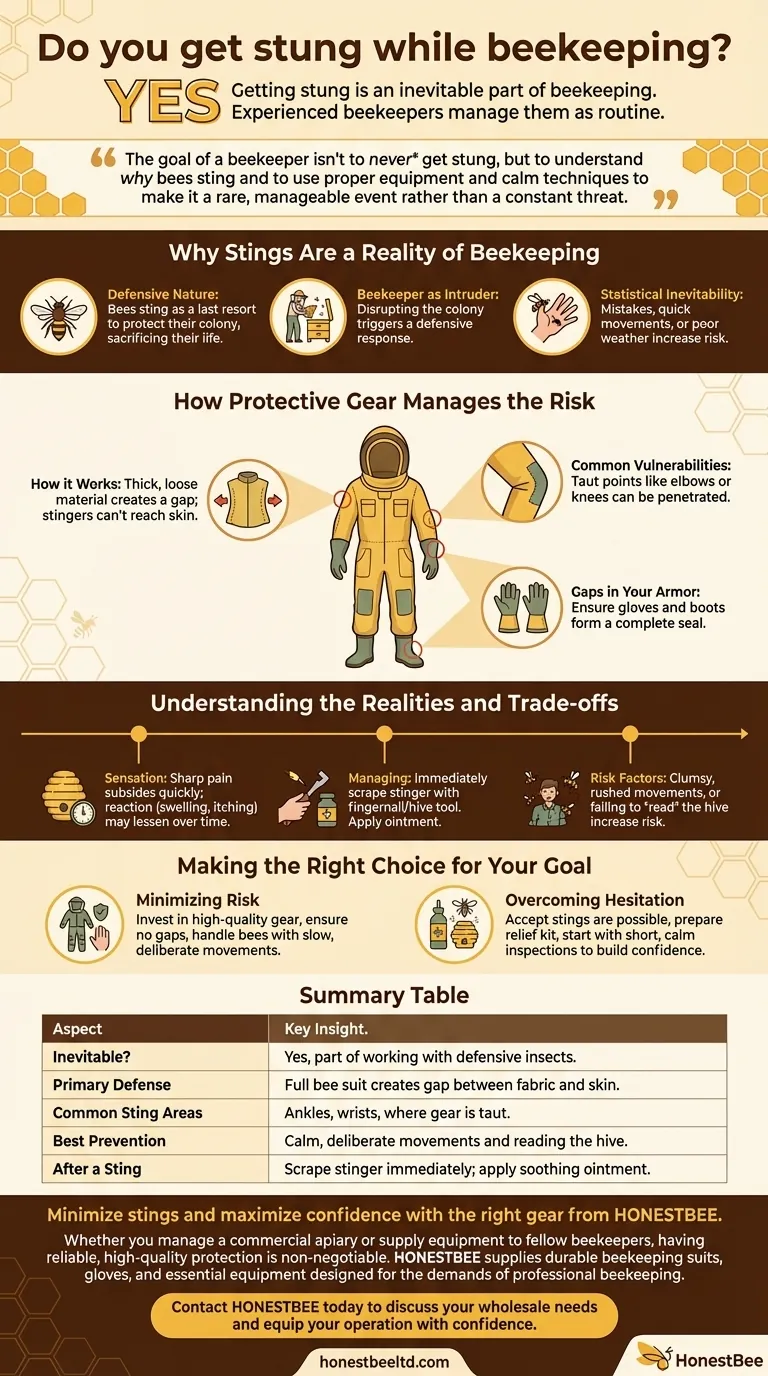Yes, getting stung is an inevitable part of beekeeping. While protective gear is highly effective, if you spend enough time working closely with tens of thousands of defensive insects, a sting is bound to happen eventually. Experienced beekeepers learn to minimize these occurrences and manage them as a routine part of the work.
The goal of a beekeeper isn't to never get stung, but to understand why bees sting and to use proper equipment and calm techniques to make it a rare, manageable event rather than a constant threat.

Why Stings Are a Reality of Beekeeping
Bees are not inherently aggressive, but they are fiercely defensive of their colony. A honeybee stings as a last resort to protect its home from a perceived threat, sacrificing its own life in the process.
The Role of the Beekeeper
As a beekeeper, you are a well-intentioned intruder. When you open a hive to inspect its health, you are disrupting the colony's environment, which can trigger this defensive response.
Statistical Inevitability
Even with the calmest demeanor, mistakes happen. Accidentally pinching a bee between your glove and a hive box, moving too quickly, or inspecting on a day with poor weather can increase the likelihood of a defensive reaction.
How Protective Gear Manages the Risk
A full bee suit is your primary line of defense and dramatically reduces the number of stings you will receive. However, it is not an infallible shield.
How a Bee Suit Works
A proper bee suit is made of thick material and is worn loosely. This creates a significant gap between the fabric and your skin, making it difficult for a bee's stinger to reach you.
Common Vulnerabilities
A sting can occur if the suit is pulled taut against your skin, for instance, when bending your elbow or knee. It is also possible, though rare, for a determined bee's stinger to penetrate the fabric itself.
Gaps in Your Armor
The most common points for stings are areas where your protective gear meets, such as the ankles or wrists. Ensuring your boots and gloves create a complete seal with your suit is critical for comprehensive protection.
Understanding the Realities and Trade-offs
Accepting the possibility of a sting is the first step. The next is understanding the experience and how to properly respond.
The Sensation of a Sting
A bee sting is painful, but for most beekeepers, the initial sharp pain subsides quickly. Over time, many find their body's reaction—the subsequent swelling and itching—lessens with repeated exposure.
Managing the Aftermath
When stung, the first step is to immediately scrape the stinger out with a fingernail or hive tool. Afterward, applying an ointment can help soothe the irritation and alleviate discomfort.
When You Are Most at Risk
Stings are not random. They are most likely to happen when a beekeeper is clumsy, rushed, or fails to "read" the hive's mood. A calm, deliberate approach is your best preventative measure.
Making the Right Choice for Your Goal
Your approach to beekeeping should be grounded in respect for the bees' defensive nature, not a fear of being stung.
- If your primary focus is minimizing risk: Invest in high-quality, thick-material gear, ensure there are no gaps in your protection, and always handle your bees with slow, deliberate movements.
- If your primary focus is overcoming hesitation: Accept that stings are a possibility, prepare a simple sting-relief kit, and start with short, calm hive inspections to build your confidence.
Understanding and respecting the bee's world is the key to becoming a confident and effective beekeeper.
Summary Table:
| Aspect | Key Insight |
|---|---|
| Inevitable? | Yes, stings are a part of working with defensive insects. |
| Primary Defense | A full bee suit creates a gap between fabric and skin. |
| Common Sting Areas | Ankles, wrists, and where gear is pulled taut against skin. |
| Best Prevention | Calm, deliberate movements and reading the hive's mood. |
| After a Sting | Scrape the stinger out immediately; apply soothing ointment. |
Minimize stings and maximize confidence with the right gear from HONESTBEE.
Whether you manage a commercial apiary or supply equipment to fellow beekeepers, having reliable, high-quality protection is non-negotiable. HONESTBEE supplies durable beekeeping suits, gloves, and essential equipment designed for the demands of professional beekeeping.
Let us help you and your customers work safer and more effectively.
Contact HONESTBEE today to discuss your wholesale needs and equip your operation with confidence.
Visual Guide

Related Products
- Cotton Beekeeping Suit and Round Hat with Veil Bee Keeper Protective Gear
- Economy Polyester Beekeeping Jacket with Veil and Hat
- Beekeeping Jacket with Hood and Veil for Beekeepers
- White Beekeeping Protective Suit and Hat with Fencing Veil for Beekeepers
- Professional Beekeeping Suit for Kids and Girls Childrens Bee Keeper Suit
People Also Ask
- What should be considered regarding the color of beekeeping clothing? Ensure Your Safety and Keep Bees Calm
- How should a beekeeping suit be hung to maintain its shape? Protect Your Investment with Proper Storage
- How should a bee suit be cleaned? Protect Your Investment and Ensure Apiary Safety
- What is recommended for beginners in beekeeping regarding protective clothing? A Complete Safety Guide for New Beekeepers
- What factors should be considered when choosing a beekeeping suit? Balance Safety, Comfort & Performance



















